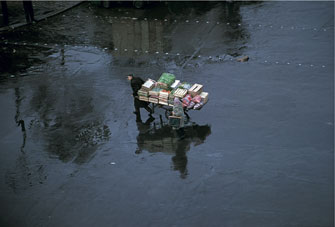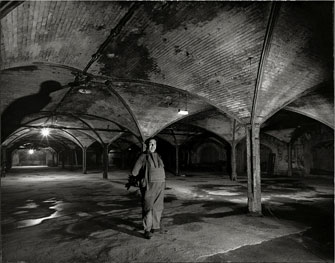The Life and Death of
The ‘Belly of Paris’

“Triporteur aux Halles.” © Atelier Robert Doisneau.
Who doesn’t love the photographs of Robert Doisneau (1912-94), maker of innumerable witty and iconic images images of Paris? I tried to pick one favorite as an example, but there are far too many. Here is one, and here is another, but have a good look at the site of his estate for the full antidepressant effect.
Even better, go to the Hôtel de Ville to see his prints in person in the just-opened (and free) exhibition “Doisneau: Paris Les Halles,” a look at the “belly of Paris,” as the city’s lost, lamented wholesale food market, which closed in 1969, used to be known. The tragedy lies not so much in the closure of the market – it was no longer really feasible to keep a massive market, with all the attendant congestion and mess, in the heart of a major metropolis – but in the destruction of its beautiful Baltard pavilions (named after the architect who designed them in the second half of the 19th century). They were replaced in 1979 by the Forum des Halles, a nasty underground shopping mall topped by hideous mirrored structures that look like upside-down umbrellas.
This exhibition is extremely timely, since those structures are now being torn down (the mall and subway station will be preserved), only three decades after they were built, to be replaced by a “canopy” that may or may not be an improvement (click here to see for yourself).
Doisneau began taking photos of Les Halles in 1933, and as soon as he heard that the market was to close, he made a commitment to shoot there once a week beginning in 1967.
His images are, as always, pure delight. He shows the market in every mood: in the sun, in the rain, at night, in the cold (vendors warming themselves by trash-can fires). He captures passersby – a fat man, an elegant lady, a terribly blasé young man taking it all in his stride with a very Parisian attitude – in the act of sailing over a trash-choked, flooded gutter. We see proud vendors, clowning butchers, tired laborers, joyous party-goers, and both vendors and customers making the famous Parisian moue while dickering over prices. The overall impression is that the market was full of camaraderie, joy and laughter, although the reality may have been a little tougher.
There are many, many gems here: a phlegmatic butcher posing with one hand on the snout of a calf and the other on his impressive knife; two girls being transported on a vegetable cart pulled by a young man; a woman in a fur coat with outrageously arched penciled-on

“Sous Sol aux Halles” (1968). © Atelier Robert Doisneau
eyebrows and an impossibly tall hat; a Groucho Marx-lookalike riding a child’s bicycle; two young women eating while standing in front of a display of dead rats (the window display is still there, at 8, rue des Halles). A wonderful three-in-one photo of a café shows its lovely ceramic decor on the left, the proud owner and his wife framed in a mirror in the center, and on the right another mirror in which we see customers going about their business, one of them looking back at the camera.
Technically, these photos are not all of the highest quality, but they were often taken on the fly under difficult conditions. One image that might have become a Doisneau icon just misses because it is out of focus: two prostitutes stand on a street corner while a caped and képi-ed policeman peeks at one of them from around the corner and a potential client glances back at the other one from the opposite side.
After documenting the life of the market, Doisneau also recorded its death – the departure of the vendors, the destruction of the pavilions (two were preserved; one is in Japan, the other in a Parisian suburb) and the deep hole left in the empty belly of Paris for a decade.
He also photographed its unworthy resurrection when the new Forum des Halles opened in 1979 and the soulless halls of the new wholesale market in Rungis, a Paris suburb.
Hôtel de Ville de Paris: 29, rue de Rivoli, 75004 Paris. Métro: Hôtel de Ville. Tel. 01 42 76 51 53. Open Monday-Saturday, 10am-7pm. Closed Sunday and public holidays. Admission: free. Through April 28. www.paris.fr
Order the exhibition catalog from Paris Update’s Amazon store at no extra cost. Click on your preferred Amazon location: France, U.S., U.K.
Please support Paris Update by ordering books from Paris Update’s Amazon store at no extra cost. Click on your preferred Amazon location: U.K., France, U.S.
Reader Reaction: Click here to respond to this article (your response may be published on this page and is subject to editing).
More reviews of Paris art shows.
© 2012 Paris Update
Favorite